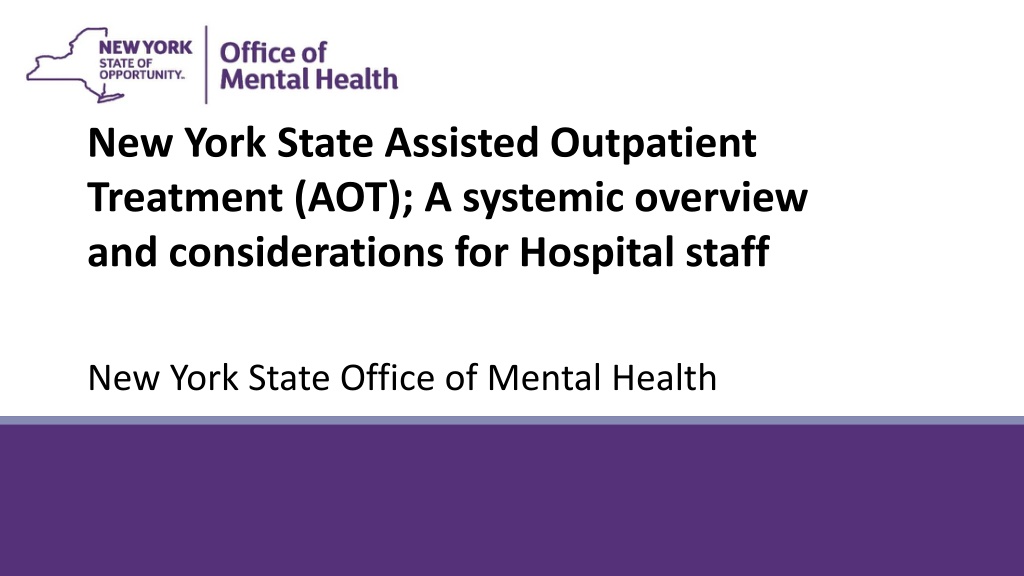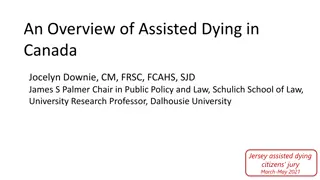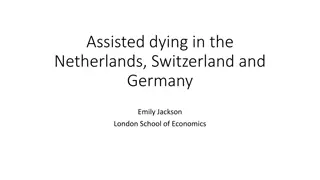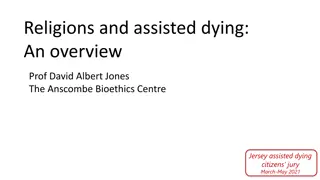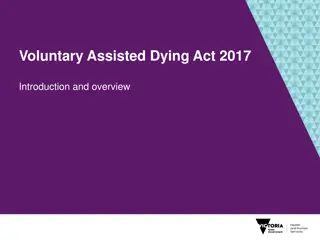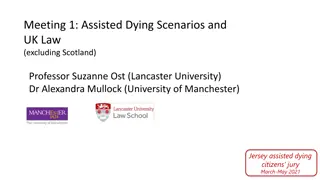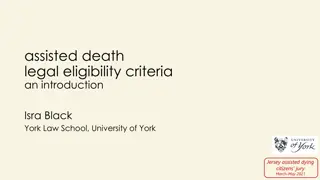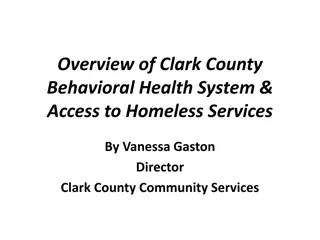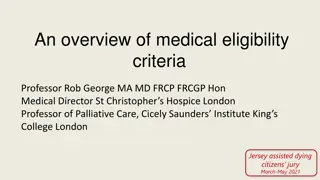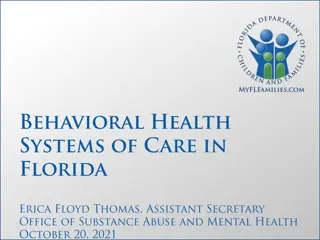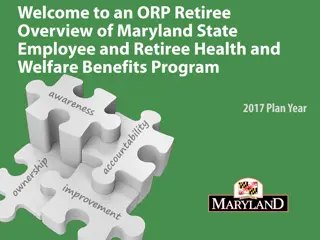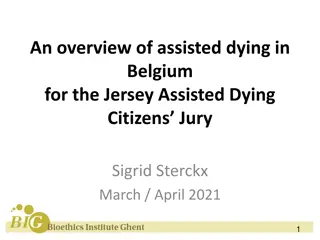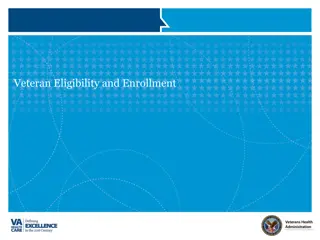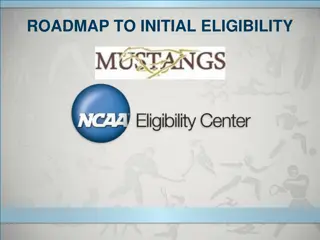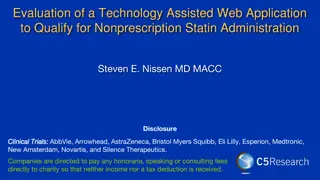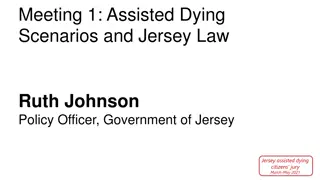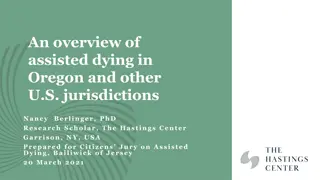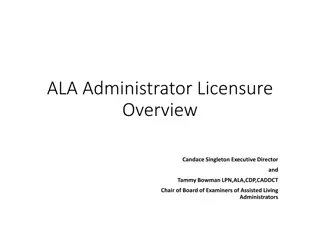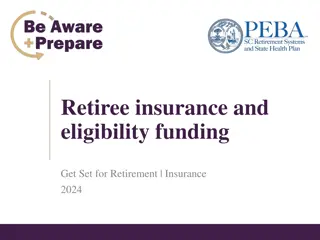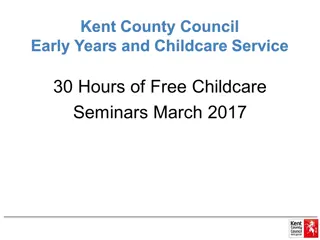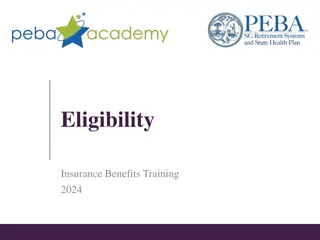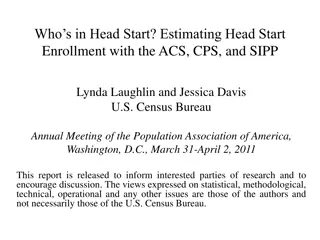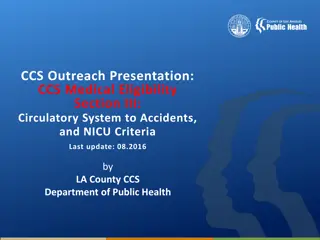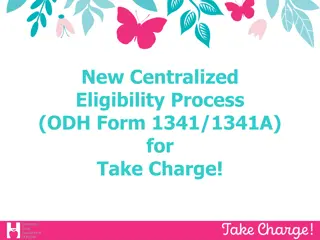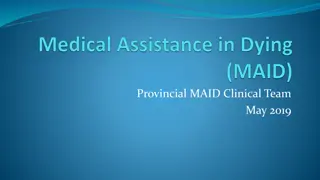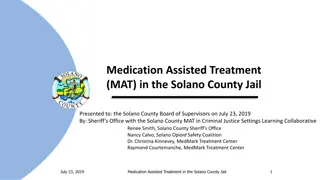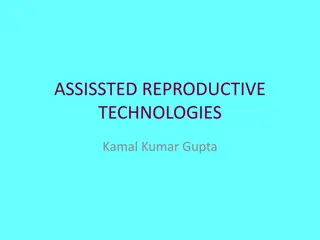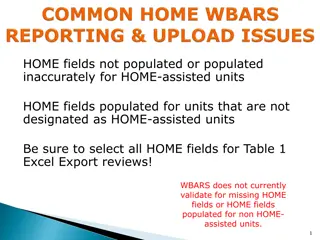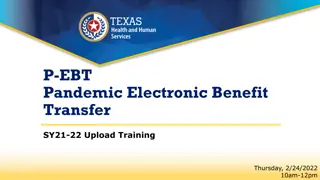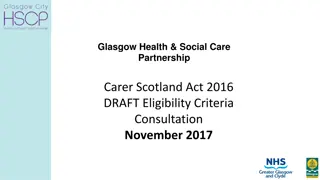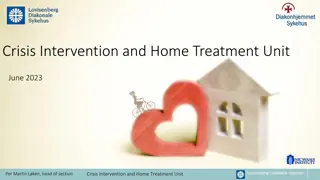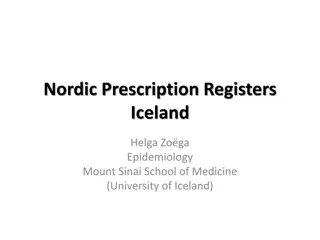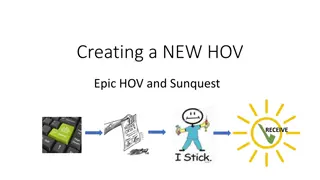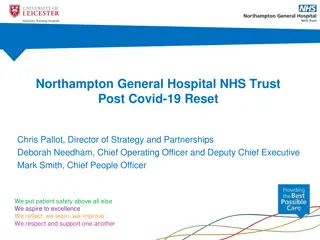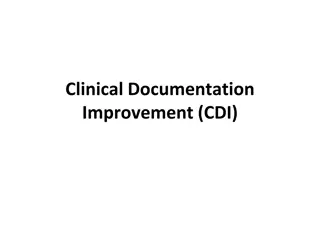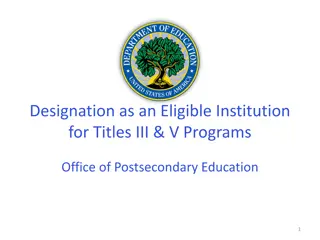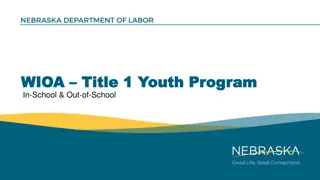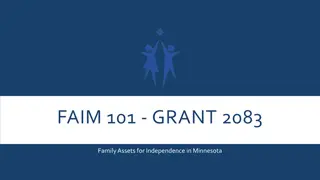New York State Assisted Outpatient Treatment (AOT): Overview and Eligibility Criteria
This overview delves into the background and purpose of New York State's Assisted Outpatient Treatment (AOT) program, established in response to Kendra's Law. It covers eligibility criteria for individuals living with mental illness who require supervision to ensure community safety. The AOT training aims to equip hospital staff with a detailed understanding of roles and practical applications within the program.
Download Presentation

Please find below an Image/Link to download the presentation.
The content on the website is provided AS IS for your information and personal use only. It may not be sold, licensed, or shared on other websites without obtaining consent from the author. Download presentation by click this link. If you encounter any issues during the download, it is possible that the publisher has removed the file from their server.
E N D
Presentation Transcript
New York State Assisted Outpatient Treatment (AOT); A systemic overview and considerations for Hospital staff New York State Office of Mental Health
Scope 101 of AOT (Background, purpose, eligibility criteria, oversight, roles, and AOT practical applications) A training for State and Local Hospital staff in New York State
3 History In January 1999, Kendra Webdale was pushed from a NYC subway platform to her death. She was pushed by a man living in the community who was not being treated for his serious mental illness. Kendra s Law (Mental Hygiene Law 9.60) was signed in August 1999 and went into effect on November 8th, 1999.
4 Purpose Kendra s Law has a dual purpose: 1. To assist individuals with mental illness to live safely in the community, and 2. To maintain safety in the community
5 Eligibility Criteria - MHL 9.60(c) Eligibility criteria for AOT are based on the following factors and clinical determinations (Note the individual must meet ALL criteria): 1. 18 years of age or older; 2. Living with a mental illness; 3. Unlikely to survive safely in the community without supervision;
6 Eligibility Criteria (continued) 4. last thirty six months been a significant factor in necessitating hospitalization in a hospital, or receipt of services in a forensic or other mental health unit of a correctional facility or a local correctional facility, not including any current period, or period ending within the last six months, during which the person was or is hospitalized or incarcerated; or History of lack of compliance with treatment - prior to the filing of the petition, at least twice within the
7 Eligibility Criteria(continued) 4. History of lack of compliance with treatment -prior to the filing of the petition, resulted in one of more acts of serious violent behavior toward self or others or threats of, or attempts at, serious physical harm to self or others within the last forty-eight months, not including any current period, or period ending within the last six months, in which the person was or is hospitalized or incarcerated; or
8 Eligibility Criteria (continued) 4. History of lack of compliance with treatment -where an order for AOT has expired within the last six months, and since the expiration of the order, the person has experienced substantial increase in symptoms of mental illness and such symptoms substantially interferes with or limits one or more life activities as determined by a director of community services who previously was required to coordinate and monitor the care of any individual who was subject to such expired assisted outpatient treatment order.
9 Eligibility Criteria(continued) 5. Unlikely to voluntarily participate in treatment; 6. Court-ordered treatment is necessary to prevent relapse or deterioration; AND 7. Likely to benefit.
10 Concentric Circles of Oversight
11 Systems Try and keep in mind, that each recipient you serve is involved in multiple systems. These systems work better when they work with rather than for an individual and are able to communicate effectively. Care Coord. Other needs Medical/Health Housing Benefits/Insur Ed/Work/ Natural Supports Med Mngmnt.
12 Key Roles & Responsibilities MHL 7.17(f) OMH AOT Program Coordinator Oversees and monitors county AOT activities, including: Timely completion of investigations Timely provision of court-ordered services
13 Key Roles & Responsibilities MHL 9.47(b) County Director of Community Services (DCS) of the Local Government Unit (LGU) Accepts referrals of at-risk individuals with mental illenss Conducts timely investigations Files petitions for AOT when appropriate Coordinates timely delivery of services The Local Governing Unit (LGU) has a statutory role to govern the oversight of county and local not for profit service providers
14 Key Roles & Responsibilities Care Coordinator (Care Manager / ACT) Weekly contact with county AOT personnel - monitor and report non-compliance with court-ordered treatment plan Mandatory weekly face-to-face contact with AOT recipient Support recipient in pursuit of treatment plan goals Assist in engagement with providers Statutory reporting requirements
15 Key Considerations for Hospitals Petitioning for AOT orders Screening for AOT eligibility should begin immediately upon admission and should consider factors related to recidivism and disengagement. The Look Back Period refers to the time range in which AOT eligibility is reviewable regarding the Hospitalizations and/or act of violence precipitated by Non-Adherence/Compliance with treatment. not including any current period, or period ending within the last six months, during which the person was or is hospitalized or incarcerated; Petitioning hospitals may use their own records OR must obtain ROI OR get other hospital records by way of subpoena. The form for State hospitals (community hospitals may use as well) to use for screening documentation can be found here: AOT_Screening_Tool_Final.pdf (ny.gov)
16 Key Considerations for Hospitals Petitioning for AOT orders (Cont.) The DCS in the county where the hospital is located should be involved as soon as possible. This can be either to help craft a treatment plan if the recipient is going to be located within their county, OR to help with outreach and intercounty collaboration. The DCS of the county where the individual is, may appoint the physician to evaluate the individual and develop the treatment plan where they are in agreement with pursuing an AOT. On-going planning and committee meetings with the county can help create regular pathways of communication and create pro-active approaches to comprehensive discharge planning that may or may not include AOT as a final option.
17 Key Considerations for Hospitals Petitioning for AOT orders (Cont.) The local county mental health staff where the individual will be referred to or move to after the hospital stay (if different from the county where the PC is located) should also be contacted immediately and can also help allocate resources and direct Single Point of Access (SPOA) applications. Referrals for all services proposed in the treatment plan should be made prior to discharge. Special considerations can be made that include inter-county transportation and service provision, as long as appropriate, designated care coordination is involved in weekly planning and all services listed on the treatment plan are being delivered.
18 Filing the Petition Requirements of the Petition: 1. Must state Each of the criteria; 2. Must present facts that support the petitioner s belief that the individual meets each criteria; 3. Must state that the individual is believed to be present or is reasonably believed to be present where the petition is filed.
19 Filing the Petition (Cont.) Physicians Affidavit/Affirmation: Must accompany the petition and completed by a physician who is not the petitioner. Stating the physician has personally examined the individual no more than 10 days prior to the submission of the petition and states the physician: Recommends AOT for the Individual and Is willing and able to testify at the hearing. Alternatively the affidavit/affirmation may state that unsuccessful attempts were made in the past 10 days to obtain the consent of the person for an examination. The physician has reason to suspect that the individual meets the criteria for AOT and Is willing and able to examine the individual and Testify at the hearing.
20 Who Gets served? The Individual who is the subject of the petition. The Mental Hygiene Legal Service. Any known Health Care Agent of the Individual. The New York State AOT Program Coordinator at the corresponding Field Office. Director of Community Service, if not the Petitioner. A copy may be personally served or mailed to individuals listed in MHL 9.29. the nearest relative of the person alleged to be mentally ill, other than the applicant, if there be any such person known. as many as three additional persons, if designated in writing to receive such notice by the individual.
21 The Hearing Testimony by a physician is required by statute. The examining physician must testify to the following: The individual meets AOT criteria; It is the least restrictive alternative; The specific treatment recommended; and Rationale for recommending AOT. The individual/Respondent may present evidence, call witnesses, and cross-examine adverse witnesses.
22 Hearing: Video Testimony for Physicians (2022 Amendment) A physician may be authorized to testify by video conference when it has been: shown that diligent efforts have been made to attend such hearing in person and the subject of the petition consents to the physician testifying by video conference; or the court orders the physician to testify by video conference upon a finding of good cause.
23 Disposition MHL 9.60(j) Evidentiary Standard: Clear and Convincing. The proposed treatment must be the least restrictive alternative. Initial orders may be granted for up to 12 months. The court may not include a category of service which has not been recommended by the physician both in his or her testimony and in the treatment plan.
24 Treatment Plans Categories of service All court-ordered treatment plans musthave either an ACT Team or a Care Coordinator. ANDmay include: Medication Blood tests and urinalysis Individual or Group Therapy Day or Partial day treatment Educational and/or vocational training activities Substance use treatment and counseling Supervised Housing
25 Treatment Plans (cont.) Individuals should be afforded the opportunity to provide input into their treatment plans and should at the very least have their plans discussed with them, as well as the following individuals if they choose: the treating physician, if any; upon the request of the individual: a person significant to the individual including any relative, close friend or person otherwise concerned with the welfare of the individual; and If the individual is unable to participate, and/or they have an Advance Directive plan or a proxy, that proxy or plan should be considered/consulted with when crafting the AOT treatment plan. MHLS can and should be present during the evaluation (whenever possible and when the individual is requesting their representation to be present) in which the treatment plan is being crafted, but they may not participate nor advise the consumer or obstruct the process in any way.
26 Discharge From Hospital Care: Considerations for AOT linkages Coordination of all needs, such as ID s, benefits, bank account status and any other supports the individual will need for success, should all be communicated with Care Coordination listed in the AOT treatment plan. It is considered a Best Practice to have Care Coordination not only present for the day of discharge, but also to assist with transport and help with helping the individual get settled into their potentially new settings.
27 Renewals MHL 9.60 (k) Petition for renewal of an existing order must be filed within 30 days prior to expiration of the current order. Timely filing stays expiration of the current order. The renewed order may not exceed 1 year from expiration of the current order.
28 Renewals (continued) Authorized petitioners for renewal of AOT orders are limited to: County Director of Community Services (DCS) Family member who acted as the original petitioner, if he or she retains his or her original status Roommate who acted as the original petitioner, if he or she retains his or her original status
29 Applications to Stay, Vacate, or Modify Orders MHL 9.60 (1) The individual, MHLS or other counsel, and any other entity acting on the individual s behalf may move to stay, vacate, or modify the AOT order. Service of all court papers is required upon the same parties served for the AOT petition that resulted in the order.
30 Removals MHL 9.60(n) When a physician determines that: An individual failed to comply with court-ordered treatment, and Efforts were made to secure compliance, and The individual may need involuntary admission to a hospital (This also applies to individuals with a missing status) Then: The County DCS may order the removal and transport of the individual to a hospital for examination to determine the need for civil commitment The hospitalization is not to exceed 72 hours.
31 Removals (continued) If, during the 72 hour period: The individual does not meet the legal standard for involuntary admission and retention, and Is unwilling to remain voluntarily Then: He or she must be released Failure to comply with an AOT order is not grounds for involuntary civil commitment or a finding of contempt of court.
32 What The Numbers Say About AOT Reduced Incarcerations by 73% Greater engagement in service and use of prescribed medication Reduced homelessness by 64% Outcome at end of an order: Half leave AOT in a positive manner/10% leave for reasons unrelated to mental illness Decrease frequency & duration of hospitalizations by 66%
33 Additional Information: To learn more about Kendra s Law, visit the OMH website: https://my.omh.ny.gov/bi/aot THANK YOU!
